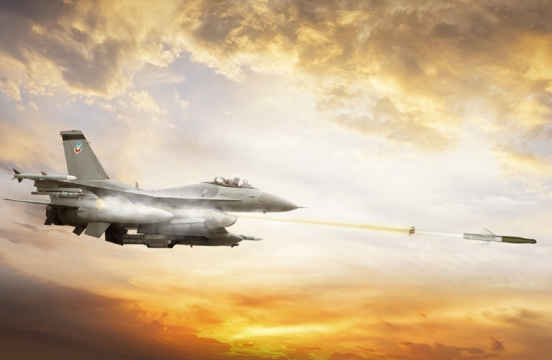U.S. Navy photo
The U.S. Navy has awarded BAE Systems a $175 million contract for more than 7,000 Advanced Precision Kill Weapon System (APKWS®) Laser-Guided Rockets.
This latest award was made under the Navy’s 2016 $600 million indefinite delivery/indefinite quantity contract, which is the contracting vehicle to supply APKWS rockets to the U.S. Navy, U.S. Marine Corps, U.S. Army and U.S. Air Force, as well as an increasing number of allied nations. This award extends that contract’s initial unit production cap and total value to meet the growing demand. The company expects additional orders to bring the total number of units for this production lot to 17,500.
“Global demand for our precision strike capabilities is being driven by a need for munitions that can strike soft targets with accuracy surrounded by friendly forces, civilians, and valuable assets,” said Marc Casseres, Director of Precision Guidance and Sensing Solutions at BAE Systems. “With APKWS, our customers get a high-quality, reliable, easy-to-use product that is designed to hit intended targets with extreme accuracy.”
BAE Systems continues to ramp up production capacity as it builds toward an annual production level of more than 20,000 units. The company is delivering APKWS rockets to meet surging customer demand while maintaining an unwavering commitment to quality. Its state-of-the-art precision guidance manufacturing facilities in New Hampshire and Texas and its strong supplier network have enabled it to accelerate full-rate production, exceed manufacturing expectations, and deliver units to the Navy ahead of schedule.
The innovative APKWS technology transforms standard 2.75-inch (70-millemeter) rockets into precision munitions by simply installing the guidance kit between the warhead and engine of an unguided rocket. The APKWS rocket’s extreme accuracy is ideal for minimizing collateral damage to assets in close proximity to targets, thereby reducing risk for troops in the field while providing close air support.
APKWS rockets are the only guided 2.75-inch rockets qualified both by the U.S. Department of Defense, and for use on multiple military rotary- and fixed-wing aircraft. APKWS rockets are used by the U.S. Navy, U.S. Marine Corps, U.S. Army, and U.S. Air Force and are available to international customers via the U.S. Foreign Military Sales process.
Source: baesystems.com
The Advanced precision kill weapon system (APKWS)
By Akela Freedom
The Advanced precision kill weapon system (APKWS) guidance kit transforms an unguided 2.75-inch (70 millimeter) rocket into a precision-guided rocket, giving warfighters a low-cost surgical strike capability.
The APKWS rocket redefines precision by hitting the target with pinpont accuracy and minimal collateral damage – critical for air-to-ground missions when you only have one shot. The rocket is proven in combat for five years running, and is the U.S. Government’s only program of record for 2.75-inch laser-guided rockets.
The APKWS rocket bridges the gap between unguided rockets and anti-armor munitions, consistently delivering pinpoint accuracy to soft targets at a low cost, that no other system can match.
Precision strike capability
The DASALS® seeker optics are essential to maximizing target acquisition
There are a number of precision-guided weapons on the market, but few consistently hit their intended target with pinpoint accuracy, while leaving minimal collateral damage. Our guidance section is designed to lock onto targets from over 3 kilometers away, keeping aircraft and laser designators at a safe distance from threats.
Innovative by design, the APKWS rocket includes advanced DASALS seeker optics located on all four guidance wings. Once fired, the wings deploy, and the optics lock in, guiding the rocket to the target – delivering accuracy when it matters most.
Combat proven
Innovative by design, the APKWS rocket includes advanced DASALS seeker optics located on all four guidance wings. Once fired, the wings deploy, and the optics lock in, guiding the rocket to the target – delivering accuracy when it matters most.
- Wing slot seals protect optics from adjacent firings, sand, and moisture prior to launch to ensure no damage or debris inhibit the seeker from locking onto targets
- Optics lock onto moving or stationary targets in open or confined areas, supporting a wide variety of missions, and eliminating the possibility of a lost or uncontrolled rocket after launch
- 40-degree instantaneous field of regard enables a broad capture area for the rocket to adjust mid-flight and stay on track to its target
- Ideal solution to engage soft or lightly armored targets when compared to a Brimstone missile
Combat proven
There are 13 launch platforms qualified with our APKWS guidance section
The APKWS rocket exceeds program requirements as the most accurate precision guided weapon in its class. It is utilized by all four U.S. armed forces, with deliveries to numerous allied countries. In combat, the rocket has achieved over a 93 percent hit rate when fired from rotary- and fixed-wing platforms.
- Fired from more than 20 different fixed- and rotary-wing platforms
- U.S. Army has achieved numerous confirmed successful engagements in support of current combat operations in Iraq and Afghanistan
- U.S. Air Force has fired hundreds of fixed-wing units in theater to date
- U.S. Marine Corps and U.S. Navy have fired thousands of combined fixed- and rotary-wing shots in total, and hundreds in combat scenarios
Flexible and modular design
Our mid-body guidance and control section is compatible with existing and new inventories of 2.75-inch (70 millimeter) rocket motors, warheads, and launchers. It simply inserts between the rocket motor and warhead for easy installation on a variety of platforms.
- Requires no modifications to the standard rocket motor, firing platform or fire control system
- Light weight allows pilots to carry more stowed weapons, to engage more targets in combat
- Requires minimal training, providing a seemless transition from firing Hydra rockets
- New design for fixed-wing platforms took just seven months to integrate onto the AV-8B Harrier
Fixed-wing specification
Rotary-wing specification
Source: baesystems.com
Related articles:









No comments:
Post a Comment